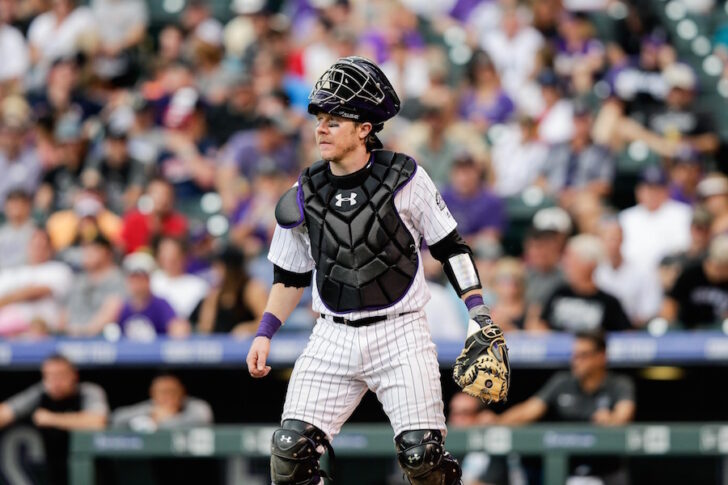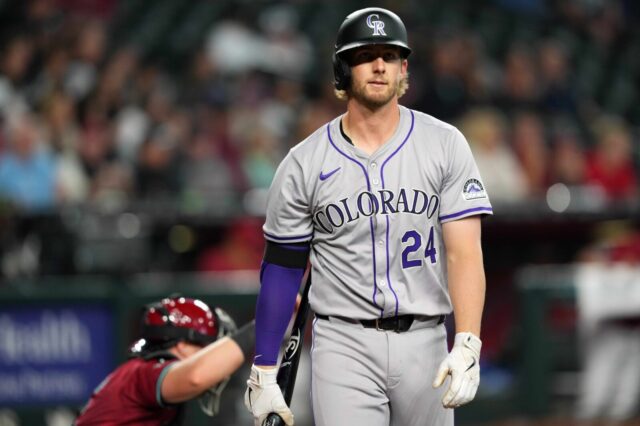In a column written on Father’s Day, I referenced the old cliché “If it ain’t broke, don’t fix it.” I was referencing the Rockies bullpen, which is now clearly in need of fixing, but it’s looking more and more like that note could have been pointed at the guys receiving the ball from those pitchers.
(For the record, I didn’t suggest the Rockies bullpen was fine as is. Even at the height of success, I’ve cautioned that the pen needs more depth.)
Both the bullpen and starting rotation have been leaking oil, spewing smoke and nearing a total breakdown of late. (Some might say an eight-game losing streak does constitute a total breakdown). The bullpen and the rotation are now in fix-it mode, and the recent decline just so happens to coincide with a change the Rockies made behind the plate with their backup catcher.
On June 15, Colorado activated catcher Tom Murphy, who was finally fully healed after suffering a broken arm during Spring Training. In a corresponding move, they sent veteran Ryan Hanigan to Triple-A. Since that time, Colorado has gone 5-8 and watched their team ERA climb from 4.10 to 4.51.
In the six games Murphy has started at catcher since his return, Colorado is 2-4 and has allowed 41 runs. That’s an average of 6.33 runs per game with Murphy behind the plate. In contrast, Rockies pitchers have allowed 43 runs over 13 starts – an average of only 3.3 runs per game with Hanigan behind the plate. We can use primary starting catcher Tony Wolters as a control in this equation, with the 229 runs allowed in his 47 games at catcher. That’s an average of 4.87 runs per game.
Although Murphy has had the misfortune of being called up right around the time the Rockies began their late-June swoon, Hanigan has clearly been demonstrably better handling the young pitching staff. He’s also been more productive at the plate.
Murphy has a much greater offensive upside than Hanigan in the big picture, but so far this season the younger Murphy has been unimpressive at the plate. Murphy has just one hit in 20 at-bats for a .050 batting average. While Hanigan isn’t making a claim for the starting job with his .256 average in his 43 at-bats, he’s clearly been a more viable option this season.
Not only has Hanigan been better at handling the pitching staff and more productive at the plate, he also brings a veteran presence to the locker room. Specifically, Hanigan brings the experience of someone who has gone through a playoff run. Three times in his 10 year career prior to joining the Rockies has Hanigan participated in the postseason. He knows what its like to suffer the highs and lows of a chase to October. Murphy, with only 40 games of MLB experience to his credit, can’t be the same kind of steadying voice in the clubhouse.
In addition to offering his experience in a playoff chase, Hanigan brings a decade of knowledge about MLB hitters to help the young and inexperienced staff. In a recent interview, Wolters said that he routinely picked Hanigan’s brain on how to attack hitters. That veteran perspective seems to be missing of late.
Hanigan wasn’t on anyone’s radar early in the season, with Wolters taking over the primary catching duties and Dustin Garneau starting the year as his backup. Garneau’s struggles at the plate have had him up and down this year, which helped open the door for Hanigan. The Rockies see big potential in Murphy, prompting his mid-June call-up once he returned to health, but clearly he needs time to get his game going.
The Rockies are on an eight-game slide and need to fix something. Swapping Murphy for Hanigan might be the way to “un-fix” a move they made that is proving to be causing more problems than it was intended to fix.



